Black locust (Robinia pseudoacacia)
-
Zebra swallowtail (Protographium marcellus)
Paw paw (Asimina triloba)
Eastern mud turtle (Kinosternon subrubrum)
We ended the survey a little early today to enjoy a very special bird – Arsenal of Democracy
Black locust (Robinia pseudoacacia)
Zebra swallowtail (Protographium marcellus)
Paw paw (Asimina triloba)
Eastern mud turtle (Kinosternon subrubrum)
We ended the survey a little early today to enjoy a very special bird – Arsenal of Democracy
It’s that time of year… You know, when spring has really sprung and you wish you had 25 hours in a day. This week I’ll be posting several short blogs starting off with a link to the Lady Bird Johnson Wildflower Center.
Happy National Wildflower Week!
Pink Lady Slipper Orchid (Cypripedium acaule)
The other day red dog & I returned home from a walk around the neighborhood and found this little guy…
 White-throated Sparrow (Zonotrichia albicollis)
White-throated Sparrow (Zonotrichia albicollis)
A very handsome sparrow. His song is one I look forward to hearing each fall when they return from their summer breeding grounds in extreme northern areas in our country and Canada.
Evidently he had collided into one the glass doors adjacent to the patio. Sadly, each spring up to one billion (yes, billion with B) die after colliding with glass structures. So what can you do if you find a bird that is stunned?
First carefully check for signs of injury. Does the bird have a broken wing or is it bleeding? If it appears to have an injury call the Wildlife Resue Leaugue hotline (703) 440-0800. They will return your call as soon as possible with further instructions.
If appears only stunned (as did the sparrow), then carefully place it in a box and wait a while to see if it recovers. Thankfully this little guy flew away after 15 minutes.
We are so fortunate in our area to have a network of dedicated volunteers who will answer your questions and if needed rehabilitate an injured bird. If you find an injured hawk or owl (as my husband and I did a few years ago) the man to call is Kent Knowles and the Raptor Conservancy of Virginia.
There is another group that is equally as dedicated to raising awareness about the problems that glass structures present to our feathered friends – Lights Out DC.
To read more about their amazing story check out this blog post by Anne Quito.

The group of hearty souls brave the winds & cool temperatures before the start of the survey…

A beautiful Spicebush Swallowtail chrysalis. You’ll never believe where it was found!
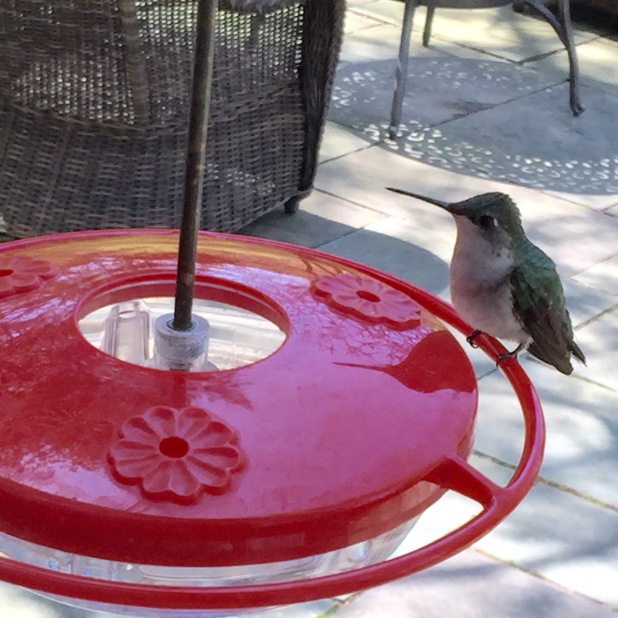
The feeders have been up for a week… Glad that they’re being put to use!
Fingers crossed that I can get back into the field next week… I’ve been sidelined the past two weeks. Have had some time to catch up on my reading…

Available on Amazon, in print and as an ebook. Fantastic guide written by my friend and fellow citizen scientist Bob Blakney. The photographs are all “donated” by the volunteers who I affectionately refer to as my Friday Friends.
No butterflies again today, but great wildlife none the less!
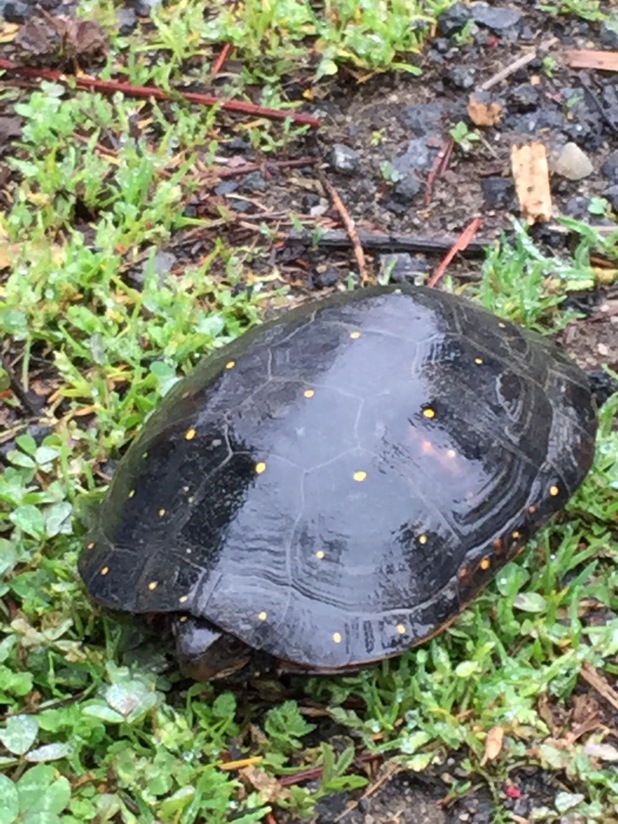
Spotted Turtle

Crawfish Chimney w/ Skunk Cabbage

Lightening Bug Larvae
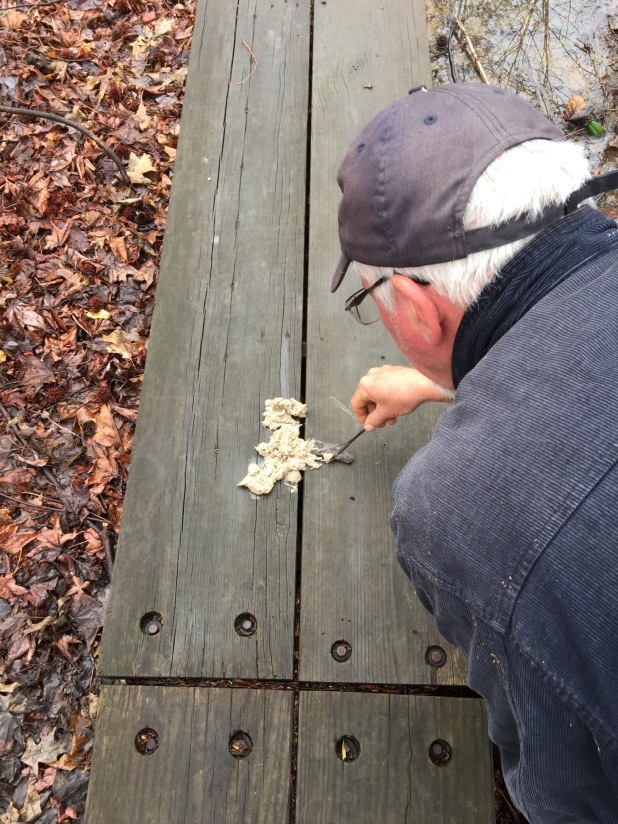
Dissecting Barred Owl Pellet
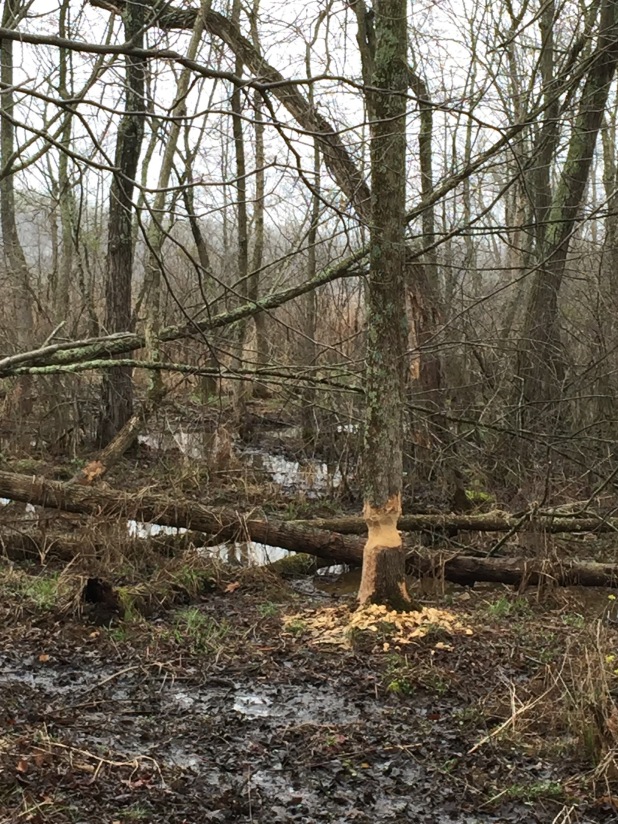
Beavers at work…
So, the butterflies and dragonflies did not fare well on “Opening Day” of survey season. The weather the past week has been typical for April – you know – all the showers that bring May flowers… After a cold and bleak winter, I am ready for butterflies and sunshine! I’ve got my fingers crossed that Mother Nature will cooperate this week – looks like we have a small window for sunshine and warm temperatures on Friday – thanks WeatherUnderground for the hourly forecast.
 In the meantime there is lots of business to take care of… Another meeting with Dr. Leslie Ries from the North American Butterfly Monitoring Network took place this week. Surveys generate A LOT of data and participatory science projects are continuing to gain popularity. The current trend to integrate web-based social media applications is now contributing volumes of information to scientists. So what do we do with all this information?
In the meantime there is lots of business to take care of… Another meeting with Dr. Leslie Ries from the North American Butterfly Monitoring Network took place this week. Surveys generate A LOT of data and participatory science projects are continuing to gain popularity. The current trend to integrate web-based social media applications is now contributing volumes of information to scientists. So what do we do with all this information?
There is an ongoing effort to transcribe historical and current data collected by the volunteers of the OBNWR count. At times this task seems overwhelming. It was discovered during research for my capstone project that the survey started by Jim Waggener and other volunteers in 1989 is the second oldest of its kind in the country. Much of the data has been organized and kept in programs and formats that are no longer widely used or supported. In order to keep volunteers interested and make the information accessible, it is imperative to plan for and manage the large volumes of data collected.
One solution to tame the unwieldy volumes of data and foster openness and sharing is NAB-NET. This program is funded by a grant from the National Science Foundation (NSF) to the University of Maryland (UMD) as well as support from the National Socio-Environmental Synthesis Center (SESYNC). This collaborative effort of professional scientists and data specialists has created an easy to use interface for grass-root organizations faced with the daunting task of data integration.
The goals of the NABMN program are: integrate and track butterfly monitoring programs that are currently ongoing in North America; standardize survey protocol (for new surveys in particular); foster sharing and openness of data collected; design suitable applications for data assimilation and engage even more volunteers. Established programs are included by special invitation and must undergo a series of questions that focus on survey protocol and data collection procedures. The program has secured funding through 2016. Future projects include integration with the MonarchNet web site as well as a comprehensive list of counts that are no longer engaged, but the historical data could provide significant insight into population trends.
Even though Opening Day 2015 was disappointing from a lepidopteran standpoint, it was fantastic to see my Friday Friends and I even got a Gold Star on my combo for my planters. 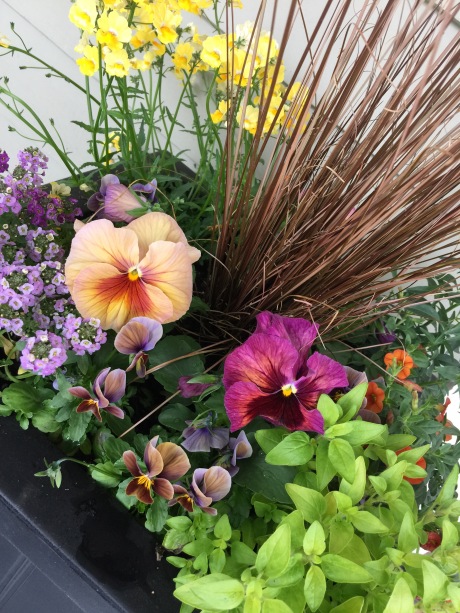
It’s the second day in a row that the day time temperatures are above 60… The Song Sparrows and Chipping Sparrows have started vocalizing in my neighborhood. Warm winds gently blow from the south-west and are quite pleasant, not biting and bitterly cold. I am cautiously optimistic that spring has arrived.
Today I spotted my first identifiable butterfly – the Mourning Cloak (Nymphalis antiopa). I was walking with a new friend, who probably thought I was absolutely nuts, I started jumping up and down clapping, pointing and yelling, “Mourning Cloak! Mourning Cloak! That’s one of the first butterflies you’ll see in the spring.”
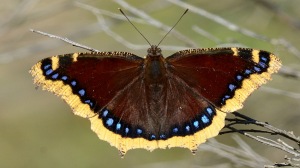 Photo courtesy of wunderground.com
Photo courtesy of wunderground.com
That’s not the only thing that I’m excited about… Tomorrow I will attend a wonderful workshop on the Magnificent Monarch, but Friday is the day that I have looked forward to for months – the start of butterfly and dragonfly survey season. Be sure to check out the new book Butterflies and Skippers of Northern Virginia by Robert Blakney. A must for any lepidoptera enthusiast!
After the survey I will visit with my dear friend and gardening guru Karen Rexrode. While I still miss her amazing catalog each spring (I still have every copy) and visiting her at Windy Hill Plant Farm, I’m thrilled that I can visit her at Merrifield Garden Center, talk plants, art, photography… did I mention plants?
I’ve got my first assignment for the season – a makeover for the flagpole landscaping and planters around town. Will post before and after pictures later. I have to say I’m not sorry to see March go! Only 81 days ’til summer, but who’s counting?
I feel like Ralphie in A Christmas Story when he receives his Little Orphan Annie Secret Society decoder pin… The anticipation, the excitement! This year I joined the citizen science fueled venture The Cornell Lab of Ornithology’s Project FeederWatch. I anxiously awaited my Research Kit in the mail and plan to start counting in the new year. (Better late than never!)
The project is a simple way that casual bird watchers of all ages can contribute data on bird populations. This is an important step to help scientists collect data. In it’s 27th season, this winter study has focused on 100 species of birds in North America. Scientists are able to glean information from the observations collected to understand broadscale movements of some species as well as identify long-term trends in abundance and distribution.
After carefully reviewing the instructions I need to determine my count site. It is typically an area that is easy to observe, like a backyard seen from a kitchen window. The area doesn’t have to be huge – the purpose is to define boundaries. Keep it simple.
The next step is a complete inspection of my feeders and surrounding landscaping. It is extremely important to create the safest and cleanest environment possible for our winter visitors. Luckily I just cleaned my feeders and suet cages – all of the rain we’ve been experiencing lately has caused some of the seed to get moldy. That can be problematic for birds. It’s important to clean feeders often.
The next steps are also crucial to prevent injuries to birds… Window strikes kill millions of birds each year. Window strikes can be prevented by breaking up the reflection – click here for some great examples. Another important step is to keep cats indoors.
I can’t wait!!! I’m almost ready to start counting. I’ll keep you posted on the process with weekly updates… Let me know if you’d like to come over and help count. The more the merrier!
This might have been the easiest Thanksgiving yet!
Here’s a peak at our 1st 100 Mile Turkey Day…
Believe it or not, we enjoyed turkey and the best mashed potatoes and gravy too!
As the last splashes of color from a fabulous fall display fade, many lament the coming winter months. While I am not a fan of the cold temperatures, I do look forward to the visiting winter birds. A neighbor, who knows of my bird nerd behavior, even picked up a copy of “The Birds of Winter” for me… Our winter visitors do not breed here, but spend about six or more months a year in our area before migrating back to their summer homes.
Quite possibly my favorite winter bird is the Dark-eyed Junco. Each October I anxiously wait their return and think about their amazing journey. They are the most widespread of all the backyard birds in North America. There is even a fantastic documentary about the Ordinary Extraordinary Junco – you can watch it here: juncoproject.org
News has been brewing on birding list serves that it’s possible we’re facing another irruption year for Snowy Owls. Young Snowy’s catch rides on arctic air masses (aka Polar Vortex) in search of food. I cannot believe I saw FOUR Snowy’s last winter IN VIRGINIA!
They are a normally a resident of the boreal tundra, think Arctic Circle, so the arrival of at least six in the Washington, DC Metro area was unprecedented. There was one in Hawaii and the Bahamas as well. I can hardly wait to see what this year brings.
If you’d like to learn more about birds, try volunteering at one of the local Christmas bird counts. The Audubon Society started the count in 1900 as an alternate event to traditional Christmas bird hunts. It is considered the longest running citizen science based census and concentrates on monitoring and data collection across the Americas.
No worries if you’re a novice birder. Experience in the field is taken into consideration when building survey teams. Beginning birders are partnered with experienced mentors. For many, this event becomes a time honored family tradition.
Here is a list of local counts:
Sunday, December 14, 2014
MANASSAS-BULL RUN
To participate, contact Audubon Society of Northern Virginia: info@audubonva.org or 703-438-6008.
SENECA MD/VA
Count has five Virginia sectors, ranging from Great Falls Park to the eastern corner of Loudoun County. To participate, email Jim Nelson: kingfishers2@verizon.net
THE PLAINS/AIRLIE
To participate, email compilers, Todd Day: blkvulture@aol.com
or Perri Borowiecki: pborowiecki@comcast.net
Monday, December 15, 2014
BROOKE (FREDERICKSBURG)
Contact Odette James: o.b.james@verizon.net
Saturday, December 20, 2014
WASHINGTON D.C.
Includes area of Virginia inside the Beltway along with Dyke Marsh. To participate, email compiler, Larry Cartwright: prowarbler@verizon.net or contact the Audubon Naturalist Society through Carol Hayes: carol.hayes@anshome.org or call
301-652-9188 extension 10.
Saturday, December 27, 2014
CENTRAL LOUDOUN
Sign up at http://www.loudounwildlife.org or contact compiler, Joe Coleman: 540-554-2542 or joecoleman@rstarmail.com
Sunday, December 28, 2014
NOKESVILLE
For more information or to register, contact Kim Hosen at 703-499-4954 or khosen@pwconserve.org
SUGARLOAF MOUNTAIN
Lucketts Sector is in northern Loudoun County. To participate contact sector leader, Joanna Taylor: 703-243-5989 or jandrtaylor@verizon.net
Sunday, January 4, 2015
CALMES NECK
Parts of western Loudoun and eastern Clarke counties. The cutoff date to join up to participate is December 21. Contact compiler, Margaret Wester:
margaretwester@hotmail.com
FORT BELVOIR
Contact compiler, Kurt Gaskill: kurtcapt87@verizon.net or 703-768-2172.
WA L K E RT O N
Count area is primarily in Middle Peninsula. Contact compiler, Fred Atwood by December 21: fredatwood@yahoo.com
To see a complete list of the area counts, visit the Virginia Society of Ornithology web site.
If the idea of facing the chilly temperatures doesn’t appeal to you, here are a few indoor events that might be of interest:
Feeder Watch: feederwatch.org
The Great Backyard Bird Count: gbbc.birdcount.org
Winter Celebration of Swans: Mason Neck State Park, December 7, 2:00. For more information visit: masonneckstateparkfriends.org
But if you’re the type that is training for the Polar Bear Plunge in the Chesapeake Bay, then you may want to find out what waterfowl are swimming with you. Join the annual Waterfowl Count sponsored by the Audubon Society of Northern Virginia.
Winter Waterfowl Count: January 24-25, contact compiler Larry Cartwright at prowarbler@verizon.net
PS – “The Birds of Winter” states that the sign of a Snow Bunting in early winter is an indication of harsh weather to come. If this is true, then we’re in BIG trouble this year. One was spotted at Mason Neck a few weeks ago and they’re not even supposed to be here!